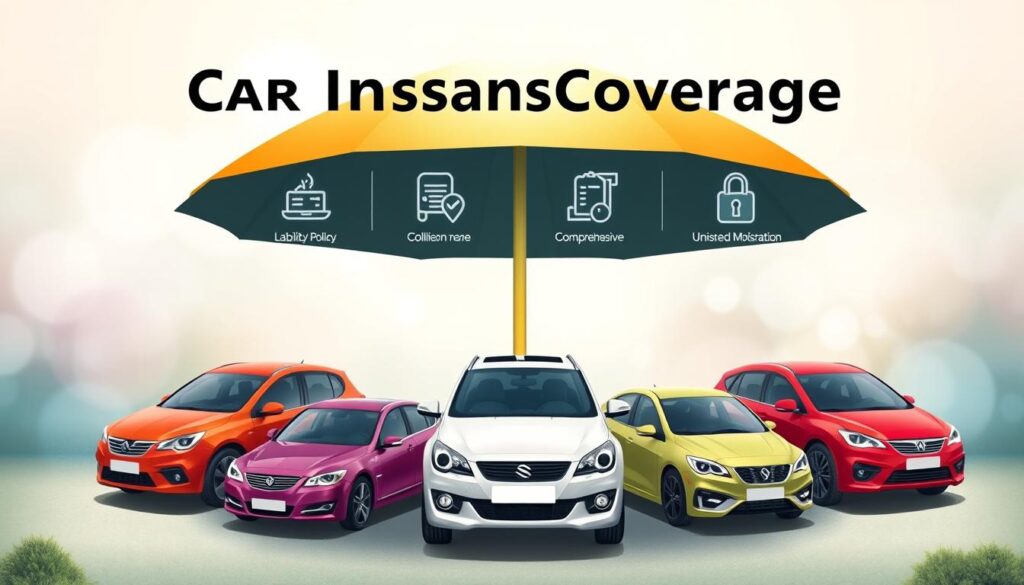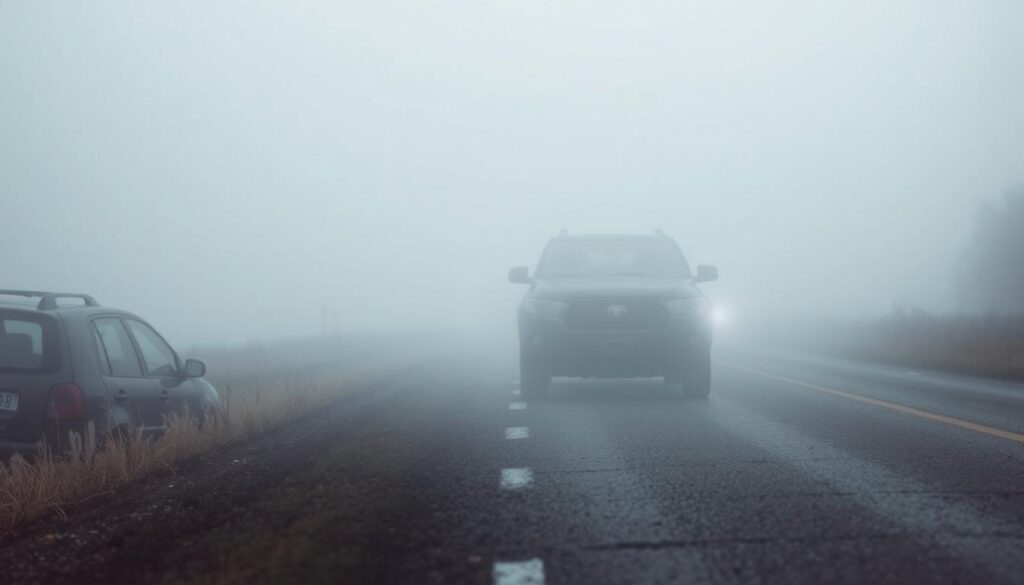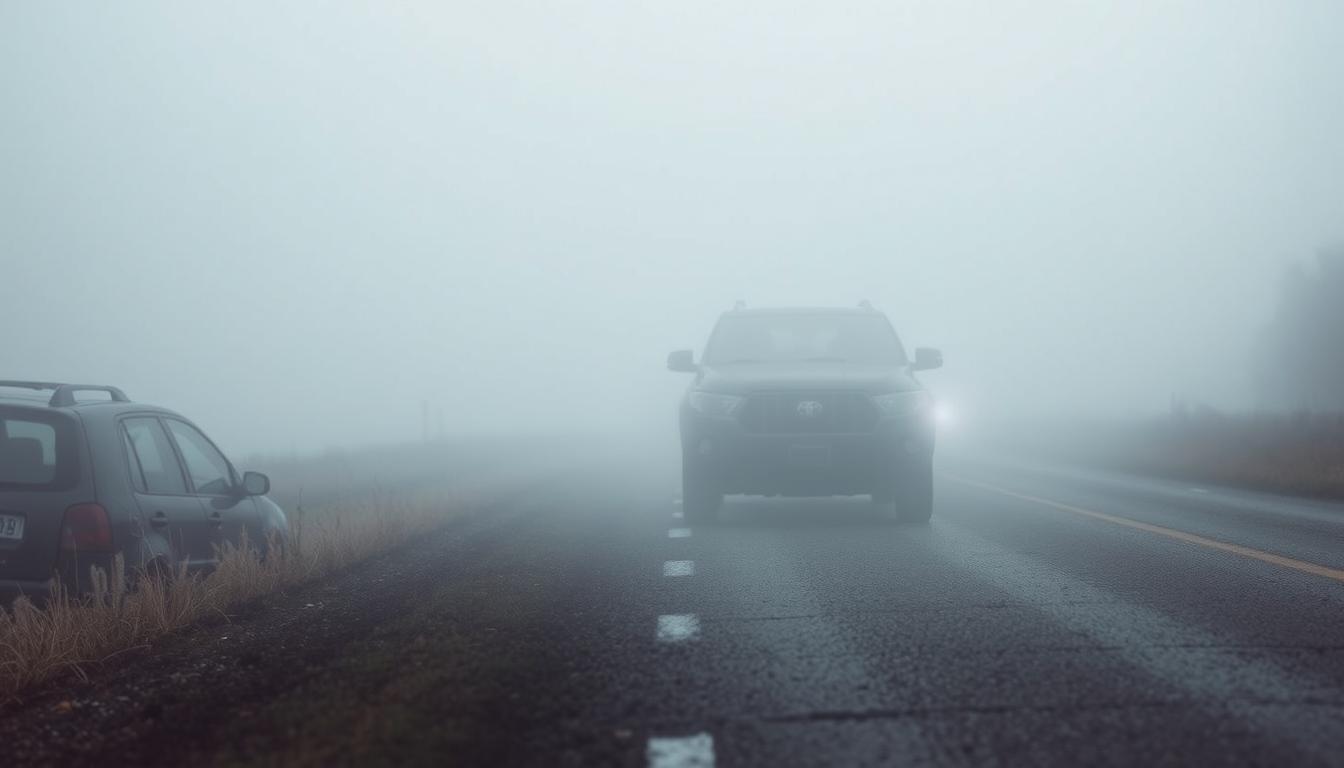In today’s fast world, many people need a car. But driving comes with risks. That’s why car insurance is key, offering a safety net for unexpected events. Knowing about the different car insurance policies helps you choose the right one for you.
Car insurance covers many scenarios, from accidents to damage to your car. By learning about these policies, you can pick the best fit for your needs and budget. This way, you can drive with confidence, knowing you’re protected.

Key Takeaways
- Car insurance is essential to protect your vehicle and finances in case of accidents or incidents.
- Different types of car insurance policies offer varying levels of coverage, from liability to comprehensive protection.
- Understanding the various policy options can help you make an informed decision and choose the right coverage for your needs.
- Liability insurance is the basic foundation, covering bodily injury and property damage to others in the event of an accident.
- Additional coverages like comprehensive and collision can provide more extensive protection for your own vehicle.
What Car Insurance Coverage Actually Means
Auto insurance policies are key to protecting your vehicle. They cover many unexpected events, like accidents, theft, and natural disasters. This ensures you’re financially safe.
Car insurance acts as a safety net. It helps you avoid huge financial losses if something bad happens. By paying a premium, you get access to various coverage options. These help you recover quickly and get back on the road.
Knowing about car insurance coverage is important for all drivers. It helps you choose the right policy for your needs and budget. Each type of coverage, like liability and comprehensive, is crucial for your financial safety.
“Car insurance is not just a legal requirement, but a crucial investment in your long-term financial security.”
Understanding your insurance policy and its coverage is essential. It lets you drive with confidence, knowing you’re ready for anything. You’ll have the auto coverage you need to protect your vehicle and finances.
Liability Insurance: The Basic Foundation
Liability insurance is key to any good car insurance plan. It protects you financially if you cause an accident. It covers damages and injuries to others. This part of insurance has two main parts: bodily injury and property damage liability.
Bodily Injury Liability Coverage
Bodily injury liability helps when you’re at fault for injuries to others in an accident. It pays for their medical bills, lost wages, and legal costs if they sue you. The law requires a minimum amount of this coverage, but experts say to get more for better liability coverage and lawsuit protection.
Property Damage Liability Coverage
Property damage liability covers damage you cause to others’ property in an accident. This includes fixing or replacing the other driver’s car and any damage to buildings or fences. Like bodily injury, the law sets a minimum for this coverage too.
State Minimum Requirements
Liability insurance is a must in most states, but the amount needed can differ. It’s smart to know your state’s minimums and consider higher limits. This way, you’re well-protected in case of a big accident.
“Liability insurance is the foundation of a well-rounded car insurance policy. It’s the coverage that protects you and your assets in the event of an accident.”
Comprehensive Coverage: Protection Beyond Accidents
Comprehensive coverage is more than just for accidents. It protects your car from theft, vandalism, natural disasters, and falling objects. This is a key part of your car insurance.
This coverage helps your car in many ways. It covers damage from hailstorms, hurricanes, floods, and even animals. This means you won’t have to pay for expensive repairs. Your car stays in great shape.
It also offers theft protection. If your car gets stolen, this coverage helps. You can either get your car back or get a new one. This is very important in places where cars often get stolen.
- Comprehensive coverage protects against a variety of non-collision-related damages, including natural disasters, theft, and vandalism.
- It can help you avoid the costly repairs associated with unexpected incidents, such as hailstorms, hurricanes, and animal collisions.
- Comprehensive coverage offers valuable theft protection, ensuring you’re covered in the event your vehicle is stolen.
Comprehensive coverage is a must-have in your car insurance. It keeps your car safe from many dangers. You can feel secure knowing your car is protected, no matter what happens.
Collision Coverage: Protecting Your Vehicle
Collision coverage is key in car insurance. It helps protect your vehicle from unexpected accidents. This coverage pays for vehicle repair and accident coverage when you crash into something. Knowing how collision insurance works is important for choosing the right policy.
Deductible Options and Costs
The deductible is a big part of collision coverage. It’s the amount you pay before your insurance helps. Deductibles can be as low as $250 or as high as $1,000 or more.
A higher deductible means lower monthly payments. But, you’ll have to pay more for repairs if you get into an accident.
When to Choose Collision Coverage
- If your vehicle is new or valuable, collision coverage is a smart choice.
- If you have a loan or lease, your lender might require it.
- In areas with many accidents, collision coverage offers peace of mind.
Coverage Limitations
Collision coverage has some limits. It doesn’t cover damage from natural disasters, theft, or vandalism. Those are usually covered by comprehensive coverage.
Also, there’s a maximum payout for collision coverage. If repairs cost more than your vehicle’s value, your insurer might declare it a total loss. They’ll pay you the vehicle’s fair market value then.
“Collision coverage is a critical component of a comprehensive car insurance policy, protecting your investment and providing financial security in the event of an accident.”
Car Insurance and Personal Injury Protection
Car insurance is important, and personal injury protection (PIP) is a key part. It offers financial help if you’re in an accident. PIP covers medical costs and lost wages, no matter who caused the crash.
PIP ensures you and your passengers get the medical care and financial help you need after an accident. It pays for many medical expenses, like hospital bills and doctor visits. It also covers wages lost if you can’t work because of injuries.
PIP does more than just cover medical costs. It also helps with lost wages if you can’t work because of an injury. This is very useful if the other driver doesn’t have enough insurance.
“PIP coverage is a vital safety net that can help alleviate the financial burden of an accident, allowing you to focus on your recovery.”
Remember, PIP rules vary by state. Some states require it as the minimum insurance. Knowing your state’s rules is key to having the right protection.
Understanding PIP coverage and how it differs from other car insurance is crucial. This knowledge helps you choose the right coverage. It ensures you and your family are financially protected in case of an accident.
Uninsured and Underinsured Motorist Coverage
Car insurance is important, and uninsured and underinsured motorist coverage is key. It protects you from accidents with drivers who have little or no insurance. This coverage helps you avoid big financial losses.
Why You Need This Protection
Hit-and-run accidents or crashes with uninsured motorists can be tough. This coverage helps pay for medical bills, lost work, and car fixes. Without it, you might face huge financial problems.
Coverage Limits and Options
- Uninsured motorist coverage helps if the other driver has no insurance.
- Underinsured motorist coverage helps if the other driver’s insurance is not enough.
- Each state has different rules for this coverage. It’s important to know what you need based on where you live.
State Requirements
Some states require this coverage, but others don’t. It’s key to check your state’s rules and adjust your policy. This uninsured motorist protection gives you financial security and peace of mind while driving.
“Uninsured motorist coverage is a valuable safeguard that can protect you from the financial consequences of a collision with a driver who has insufficient or no insurance.”

Gap Insurance: Protecting Your Investment
Buying a new car comes with a hidden risk: depreciation. Right after you drive it off the lot, its value can drop by up to 20% or more. This leaves you at risk if your car is totaled or stolen, as the insurance might not cover the loan or lease balance.
Gap insurance is here to protect your investment. It covers the gap between your car’s actual cash value and what you still owe on your loan or lease. This insurance is a lifesaver, preventing you from facing a large payoff when your car is no longer usable.
Gap insurance is especially useful in certain situations:
- You have a loan/lease payoff on your vehicle, meaning you still owe money on the car.
- Your car has depreciated significantly in value, and the insurance payout would not cover the remaining balance.
- You’re planning to replace your car with a newer model, and you want to avoid being upside-down on your loan or lease.
Adding gap insurance to your coverage can safeguard your investment and shield you from the financial hit of depreciation protection. It’s a small investment for the peace of mind that comes with knowing you’re protected in case of an unexpected loss or total write-off.
“Gap insurance is a must-have for anyone financing or leasing a new car. It can mean the difference between a smooth new car replacement and being stuck with a substantial financial obligation.”
Medical Payments Coverage and Its Benefits
Medical payments coverage is a key part of car insurance. It helps pay for medical costs after an accident. This coverage, also known as “med pay,” protects you and your passengers, no matter who’s at fault. It’s a great addition to your health insurance, covering costs your primary plan might not.
Who and What Is Covered
This coverage is for the driver, passengers, and even pedestrians hit by the car. It covers many medical costs, like:
- Emergency medical treatment
- Ambulance transportation
- Hospital stays
- Surgical procedures
- Rehabilitation services
Coverage Limits
The coverage amount varies, from $1,000 to $10,000 per person. Your choice depends on your budget, how many people you drive, and state laws. Higher limits mean more protection but cost more.
“Medical payments coverage can be a lifesaver when it comes to unexpected medical costs after a car accident.”
Knowing the benefits of medical payments coverage helps you choose the right protection. It offers peace of mind and financial security in accidents. You and your passengers get the care they need without huge medical bills.

Rental Car and Roadside Assistance Coverage
Being in an accident or having your car break down is stressful. Rental car and roadside assistance coverage can help. They offer convenience and peace of mind during unexpected times.
Rental car coverage helps pay for a rental while your car is fixed. It’s great if you need your car for work or daily life. You won’t have to worry about finding a way to get around or pay for a rental yourself.
Roadside assistance offers emergency services like towing, jump-starts, and tire changes. It’s a big help if you’re stuck on the side of the road. Emergency assistance also includes lockout help, fuel delivery, and winching if your car is stuck.
- Rental car coverage can help cover the cost of a rental car while your vehicle is being repaired after a covered accident.
- Roadside assistance provides emergency services like towing, jump-starts, and tire changes, helping you get back on the road quickly.
- Emergency assistance can include services like lockout assistance, fuel delivery, and winching if your car gets stuck.
“Having rental car and roadside assistance coverage gives me the peace of mind I need, knowing I’m protected in case of unexpected car troubles or accidents.”
When looking for car insurance, think about adding these coverages. They offer support and convenience during tough times. They help you get back on the road with little disruption to your life.
Conclusion
Looking into different car insurance policies helps you make a smart choice. You can find the right coverage for your needs. This includes everything from basic liability to extra services like gap insurance and roadside help.
It’s important to compare policies and think about what you really need. Whether you’re a new driver, a family on the go, or someone who’s been driving for years, picking the right insurance is key. It gives you peace of mind and protects your wallet.
Your car insurance is more than a must-have. It shows who you are as a driver and what you value financially. By looking into your options and picking the best customized coverage, you can drive with confidence. You’ll know you and your car are safe, no matter what comes next.
FAQ
What is the purpose of car insurance coverage?
Car insurance coverage protects you financially in case of accidents, theft, or damage. It covers repair costs, medical bills, and liability claims. This way, you won’t face all the expenses alone.
What is liability insurance, and why is it required?
Liability insurance is key in most car insurance policies. It pays for damages and injuries you cause in an accident. States require it to legally drive a vehicle.
What does comprehensive coverage protect against?
Comprehensive coverage guards your vehicle against non-collision damages like theft, vandalism, and natural disasters. It helps avoid the high costs of repairs or replacement.
How does collision coverage work, and when should I consider it?
Collision coverage pays for repairs if your vehicle hits something. It’s good for newer or high-value cars. Your deductible affects your premium and what you pay out-of-pocket.
What is Personal Injury Protection (PIP) coverage, and how does it differ from other types of coverage?
PIP coverage pays for medical costs and lost wages, no matter who’s at fault. It’s different from liability coverage, which covers damages to others. PIP is great if you have little health insurance or need to cover your own medical costs.
Why is uninsured and underinsured motorist coverage important?
This coverage protects you if hit by an uninsured or underinsured driver. It helps cover your injuries and damages when the other driver can’t.
How can gap insurance help me if my car is totaled?
Gap insurance pays the difference between your car’s value and your loan or lease if it’s totaled. It’s useful for new or leased cars that depreciate fast.
What does medical payments coverage provide, and how does it complement health insurance?
Medical payments coverage pays for medical bills after an accident, no matter who’s at fault. It helps with deductibles, co-pays, and other costs, making up for what health insurance doesn’t cover.
What additional coverages can provide convenience and peace of mind?
Rental car reimbursement and roadside assistance offer convenience and peace of mind. Rental car reimbursement covers rental costs while your car is fixed. Roadside assistance helps with emergencies like flat tires and towing.
